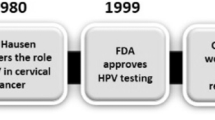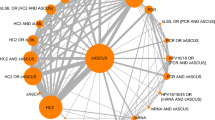Abstract
Six European, randomized, controlled trials that will compare human papillomavirus (HPV) testing with cytological testing for cervical screening are under way. We reviewed the results published so far to compare the benefits and costs for participating women. At baseline screening, use of HPV testing increased the detection of cervical intraepithelial neoplasia (CIN) grade 2+. Detection of CIN3+ was significantly increased in two trials (relative risks [RRs] 1.70 and 2.26), but not in three other trials (RRs 1.03, 1.09 and 1.31). In three trials, seven extra women had a false-positive test for each extra detected CIN2+ case; although, in another trial, this number was 49 in women ≥35 years of age. The outcome of HPV testing versus cytological testing depends not only on the relative accuracy of the primary test but also on how radical the different triage procedures are. In two trials with published outcomes from the subsequent screening round, an approximately 50% reduction in CIN3+ detection was evident in the subsequent screening. However, in these two trials the screening modalities changed between the baseline and subsequent screening rounds, so these data do not show the effect of a switch from primary screening with cytological testing to primary screening with HPV testing.
Key Points
-
In trials undertaken within European, well-established, population-based, organized screening programs, use of HPV testing compared with cytological testing increased the detection rate of CIN2+ by about 50%
-
The detection rate of CIN3+ was significantly increased in only two of five trials
-
For each extra detected CIN2+ case, about seven extra women had a false-positive screening test, although in one trial this number was 49 in women aged 35 years or older
-
A 50% reduction in CIN3+ detection at the subsequent screening of two studies is not the result of a change of primary screening from cytology only to HPV testing only
-
The key public health challenge is now to find the optimum triage procedure for women who test positive for HPV at primary screening
This is a preview of subscription content, access via your institution
Access options
Subscribe to this journal
Receive 12 print issues and online access
$209.00 per year
only $17.42 per issue
Buy this article
- Purchase on Springer Link
- Instant access to full article PDF
Prices may be subject to local taxes which are calculated during checkout
Similar content being viewed by others
References
IARC. IARC Monographs on the Evaluation of Carcinogenic Risks to Humans, Volume 90: Human Papillomaviruses (International Agency for Research on Cancer, Lyon, 2007).
IARC. IARC Handbooks of Cancer Prevention, Volume 10: Cervix cancer screening (International Agency for Research on Cancer, Lyon, 2005).
Koliopoulos, G. et al. Diagnostic accuracy of human papillomavirus testing in primary cervical screening: a systematic review and meta-analysis of non-randomized studies. Gynecol. Oncol. 104, 232–246 (2007).
Cuzick, J. et al. Overview of human papillomavirus-based and other novel options for cervical cancer screening in developed and developing countries. Vaccine 26 (Suppl. 10), K29–K41 (2008).
Elfgren, K. et al. Colposcopic and histopathologic evaluation of women participating in population-based screening for human papillomavirus deoxyribonucleic acid persistence. Am. J. Obstet. Gynecol. 193, 650–657 (2005).
Naucler, P. et al. Human papillomavirus and Papanicolaou tests to screen for cervical cancer. N. Engl. J. Med. 357, 1589–1597 (2007).
Naucler, P. et al. Efficacy of HPV DNA testing with cytology triage and/or repeat HPV DNA testing in primary cervical cancer screening. J. Natl Cancer Inst. 101, 88–99 (2009).
Bulkmans, N. W. et al. POBASCAM, a population-based randomized controlled trial for implementation of high-risk HPV testing in cervical screening: design, methods and baseline data of 44,102 women. Int. J. Cancer 110, 94–101 (2004).
Bulkmans, N. W. et al. Human papillomavirus DNA testing for the detection of cervical intraepithelial neoplasia grade 3 and cancer: 5-year follow-up of a randomised controlled implementation trial. Lancet 370, 1764–1772 (2007).
Ronco, G. et al. Human papillomavirus testing and liquid-based cytology in primary screening of women younger than 35 years: results at recruitment for a randomised controlled trial. Lancet Oncol. 7, 547–555 (2006).
Ronco, G. et al. Human papillomavirus testing and liquid-based cytology: results at recruitment from the new technologies for cervical cancer randomized controlled trial. J. Natl Cancer Inst. 98, 765–774 (2006).
Ronco, G. et al. Results at recruitment from a randomized controlled trial comparing human papillomavirus testing alone with conventional cytology as the primary cervical cancer screening test. J. Natl Cancer Inst. 100, 492–501 (2008).
Kitchener, H. C. et al. HPV testing in routine cervical screening: cross sectional data from the ARTISTIC trial. Br. J. Cancer 95, 56–61 (2006).
Kotaniemi-Talonen, L. et al. Routine cervical screening with primary HPV testing and cytology triage protocol in a randomised setting. Br. J. Cancer 93, 862–867 (2005).
Kotaniemi-Talonen, L. et al. Screening with a primary human papillomavirus test does not increase detection of cervical cancer and intraepithelial neoplasia 3. Eur. J. Cancer 44, 565–571 (2008).
Sankaranarayanan, R. et al. HPV screening for cervical cancer in rural India. N. Engl. J. Med. 360, 1385–1394 (2009).
Mayrand, M. H. et al. Randomized controlled trial of human papillomavirus testing versus Pap cytology in the primary screening for cervical cancer precursors: design, methods and preliminary accrual results of the Canadian cervical cancer screening trial (CCCaST). Int. J. Cancer 119, 615–623 (2006).
Mayrand, M. H. et al. Human papillomavirus DNA versus Papanicolaou screening tests for cervical cancer. N. Engl. J. Med. 357, 1579–1588 (2007).
Davies, P. et al. A report on the current status of European research on the use of human papillomavirus testing for primary cervical cancer screening. Int. J. Cancer 118, 791–796 (2006).
Clayton, D. & Hills, M. Statistical Models in Epidemiology (Oxford University Press, Oxford, 1993).
Chaudhary, M. A. & Stearns, S. C. Estimating confidence intervals for cost-effectiveness ratios: an example from a randomized trial. Stat. Med. 15, 1447–1458 (1996).
Rebolj, M. et al. Human papillomavirus triage of women with persistent borderline or mildly dyskaryotic smears: comparison of costs and side effects of three alternative strategies. Int. J. Cancer 121, 1529–1535 (2007).
Svendsen, A. L. et al. Breast cancer incidence after the introduction of mammography screening: what should be expected? Cancer 106, 1883–1890 (2006).
National Cancer Institute. Cervical cancer screening: HPV testing [online], (2009).
Rappaport, K. M. et al. Adoption of liquid-based cervical cancer screening tests by family physicians and gynecologists. Health Serv. Res. 39, 927–947 (2004).
Acknowledgements
The authors would like to thank Sisse Helle Njor and Kristine Bihrmann for their statistical advice.
Author information
Authors and Affiliations
Corresponding author
Ethics declarations
Competing interests
The authors declare no competing financial interests.
Rights and permissions
About this article
Cite this article
Lynge, E., Rebolj, M. Primary HPV screening for cervical cancer prevention: results from European trials. Nat Rev Clin Oncol 6, 699–706 (2009). https://doi.org/10.1038/nrclinonc.2009.167
Published:
Issue Date:
DOI: https://doi.org/10.1038/nrclinonc.2009.167
This article is cited by
-
Predictors of cervical cancer screening among Kenyan women: results of a nested case-control study in a nationally representative survey
BMC Public Health (2018)
-
Human papillomavirus infection and cervical dysplasia in female sex workers in Northeast China: an observational study
BMC Public Health (2015)
-
Protecting the underscreened women in developed countries: the value of HPV test
BMC Cancer (2014)
-
Detection and Clinical Management of Cervical Pathology in the Era of HPV
Current Obstetrics and Gynecology Reports (2014)



